#Ancient rome in 3D
Explore tagged Tumblr posts
Text
Digital model of Ancient Rome released
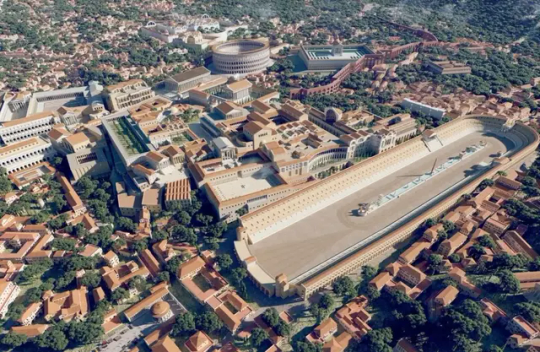
Image Credit: FLYOVERZONE
Rome Reborn 4.0, a digital model of Ancient Rome has just been released by archaeologist, Dr Bernard Frischer. Published by Flyover Zone, the model is a reconstruction of the entire city of Ancient Rome for academic study and virtual tourism. Rome Reborn provides a birds-eye perspective of the complete digital model, enabling users to glide above the historic landmarks while listening to expert narrations about 43 monuments, temples, structures, and locations.
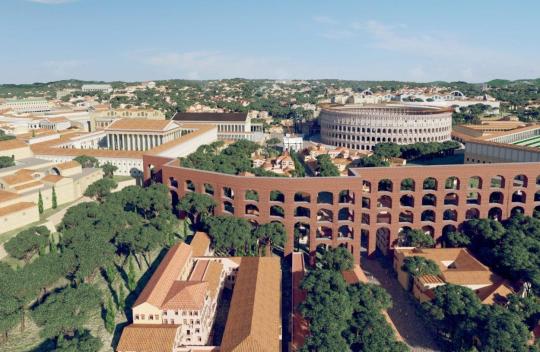
Dr Frischer said, “Rome Reborn 4.0 is the culmination of more than twenty-seven years of collaborative international work in using digital tools to research cultural history and bring it to life.” According to the project leaders, the virtual tour can be used by teachers on Yorescape, a mobile and web app that takes their students on virtual field trips, or by armchair travellers to explore the heritage sites of the ancient capital of the Roman Empire.
Rome Reborn 4.0 represents the most recent iteration of an urban model that Dr Frischer has led since 1996. Rome Reborn has been a globally collaborative project from its inception, uniting specialists in Roman archaeology, computer graphics, and Virtual Reality design. The project’s earlier versions include 1.0 (2007), 2.0 (2008), and 3.0 (2018). Video fly-throughs of these previous versions have been viewed by millions of people worldwide. Similar to its earlier versions, Rome Reborn 4.0 portrays the city as it might have appeared at its zenith in the year AD 320, just before the capital’s relocation to Constantinople. According to Flyover Zone, “This reconstruction of ancient Rome’s urban landscape adheres to scientific accuracy based on the available but fragmentary historical evidence. As new findings and interpretations of this evidence emerge, the Flyover Zone team continuously updates Rome Reborn to ensure it remains a dependable and comprehensive visualization of the city.”
BY :Mark Milligan
1K notes
·
View notes
Text
I love this
740 notes
·
View notes
Text
I did another statuee. This time it's Venus Callipyge, a Roman recreation of the Greek original
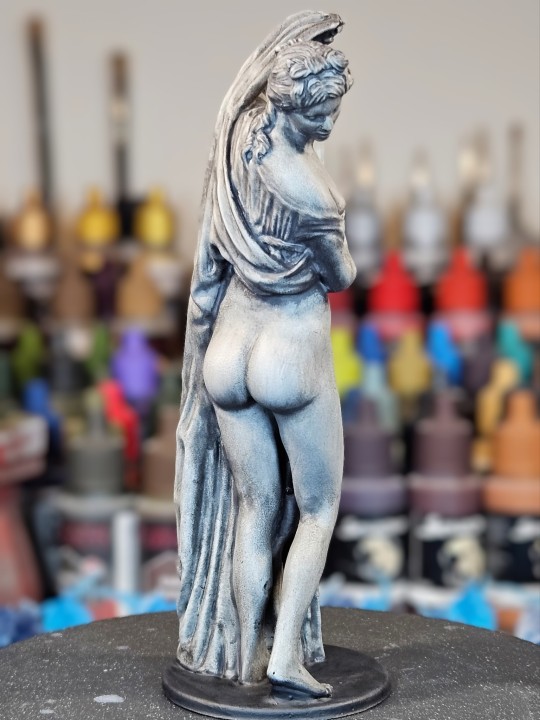
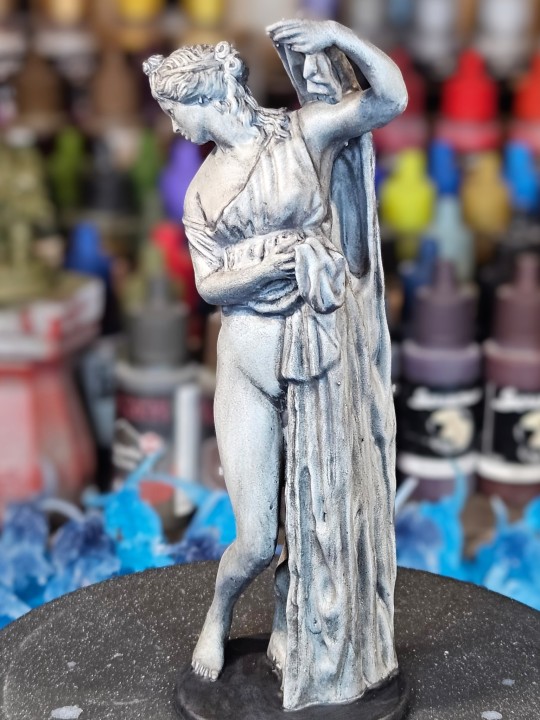
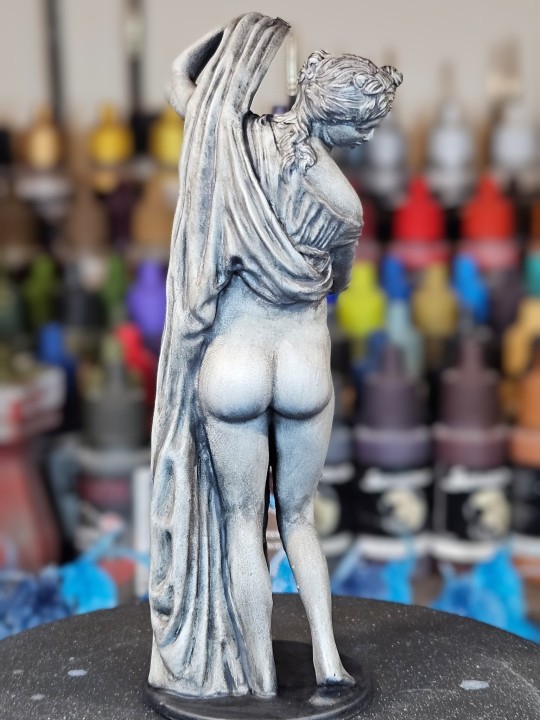
Apparently the name, Venus of the Beautiful Buttocks, is falsely attributed, but it does probably depict Venus (or Aphrodite in the original)
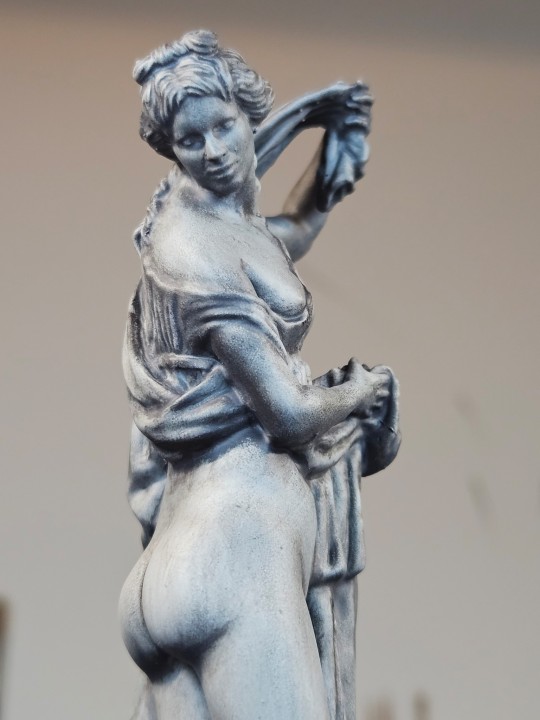
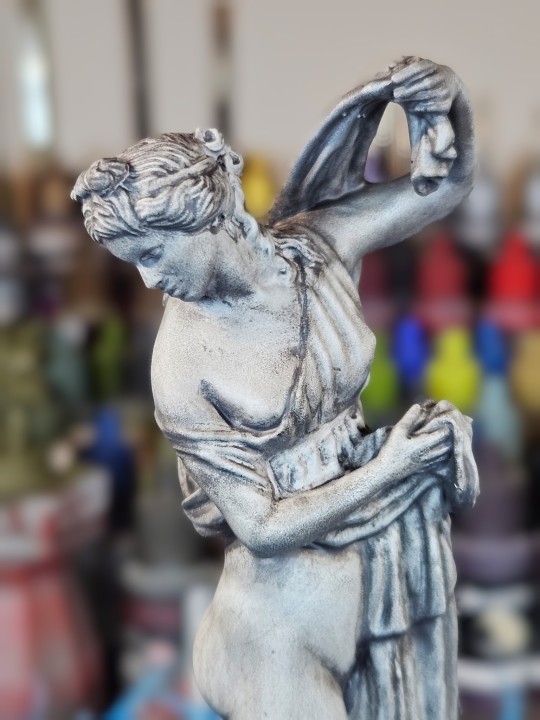

Oh also when it resurfaced in the 1500s it was headless, and the head was reconstructed. I wonder how many ancient works of art were reconstructed to the same degree as that famously terrible Jesus painting restoration and have just been quietly forgotten or destroyed out of embarrassment, the restoration artist banished from the kingdom

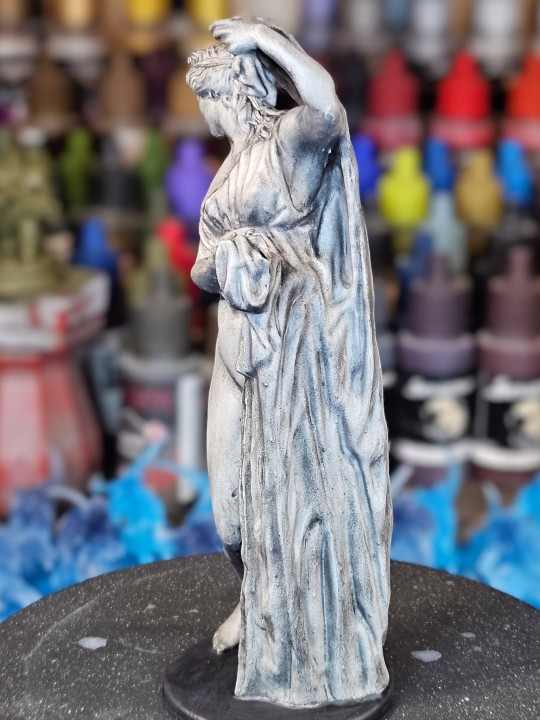
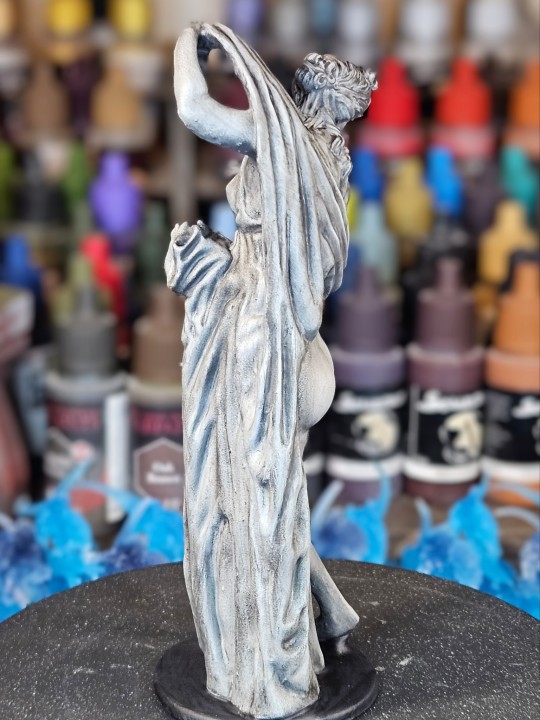
#art#painting#canopiancatboyart#miniature#miniatures#3d printing#miniature painting#oil painting#ancient history#statue#roman statue#venus#venus callipyge#ancient rome#rome#greece#ancient greece#roman mythology#greek mythology#greek statue
105 notes
·
View notes
Text

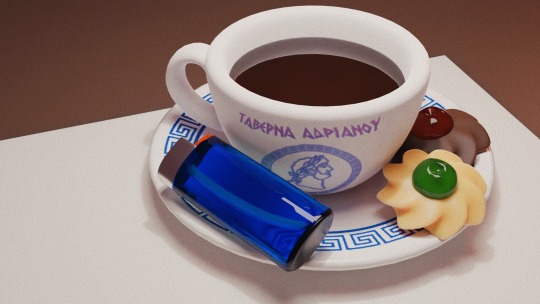
After much work, months of work, I think I figured out how uvs work!! Unfortunately my experiments crashed Blender and I lost my lighter asset😰I hope to finish this scene and learn how to get better lighting next
38 notes
·
View notes
Text

My Tali sets from VR-Soft Games arrived today. I don’t know why I was thinking the coins would be metal: they’re chipboard, but for all that very nicely printed and made imo. I really like that they were printed somewhat sloppily so that the coin art would not center perfectly with the die-cuts (and not exactly the same as one another either): I am 100% sure this was done on purpose to mimic hand-minted coins.
My own 3D set is shown by comparison (smaller, not marked with numbers). I have obtained some “vanilla” and also plain translucent resin and have ordered some dyes with which to experiment with coloring resin to play with, and will probably be printing more tali myself.
0 notes
Text

Anaglyph image of Emperor's Antoninus Pius' sculpture.
https://skfb.ly/oWFvY
#photography#photogrammetry#3d model#3d reconstruction#ancient rome#cultural heritage#anaglyph#3D#2D
1 note
·
View note
Text
This is another free course on FutureLearn that I need to get around to finishing (I pay for Premium so I'm not constrained by the 6 week duration available for free). I've worked to about halfway, and I've found it helpful as a beginner to have this accessible material with which to interact.
Course Description Taken From FutureLearn:
Explore ancient Rome through a unique, historically accurate 3D model.
Take a guided tour around ancient Rome with expert Professor Matthew Nicholls, using his detailed and award-winning 3D digital model of the city. Explore Rome’s architecture and how it was used - how did Romans worship their gods and meet their political masters? How was drinking water supplied to the city’s million inhabitants? Moving seamlessly between footage of contemporary Rome and the digital model (including interactive elements), you’ll explore these questions and much more.
Use this insight to inform your own encounters with the eternal city and the study of ancient history more generally.
/end of extract
#university of reading#rome: a virtual tour of the ancient city#accessible#free online learning#free resource#free education#architecture#history#rome#ancient history#ancient#classical studies#antiquity#classical antiquity#ancient architecture#classical rome#ancient rome#roman empire#roman history#ancient city#virtual tour#3D digital model#Professor Matthew Nicholls#roman republic#archaeology#human history#classical history
0 notes
Text
youtube
1 note
·
View note
Text
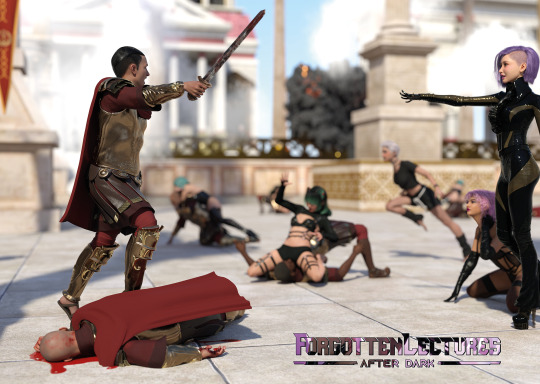
did some research on roman history and found some interesting facts on goths raiding rome... and we know, the internet is always correct so...
0 notes
Text
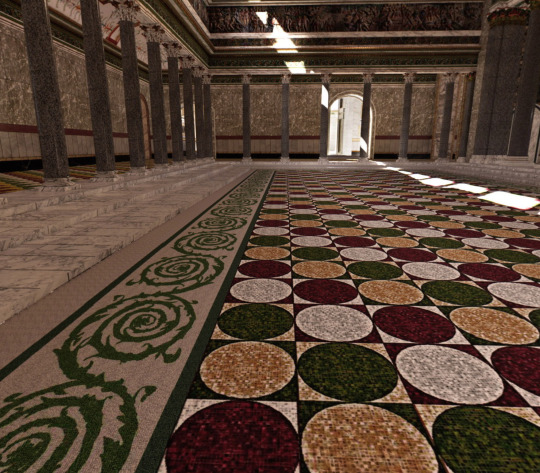
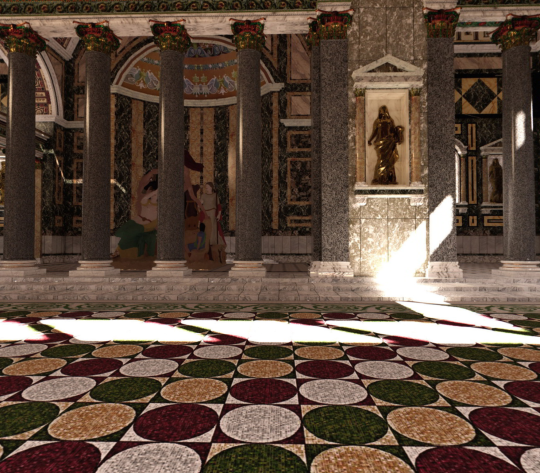
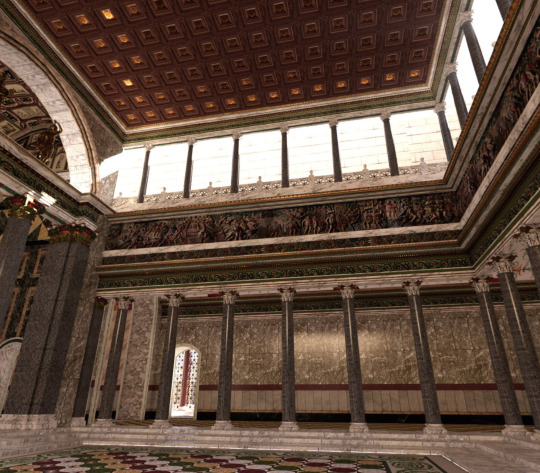
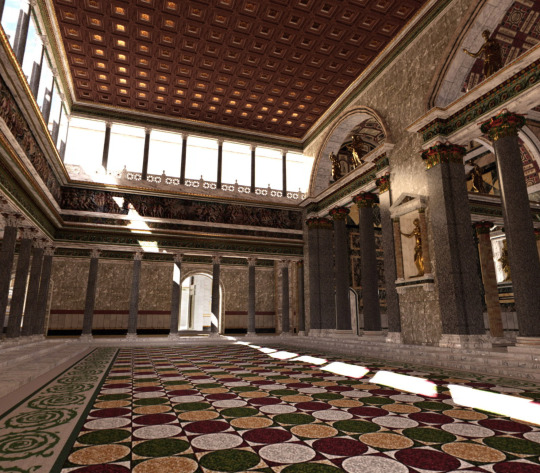
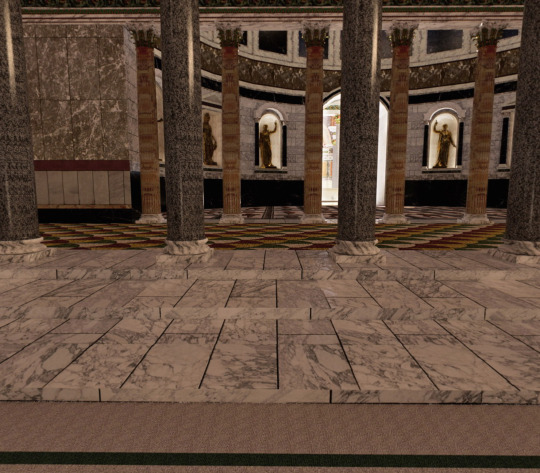
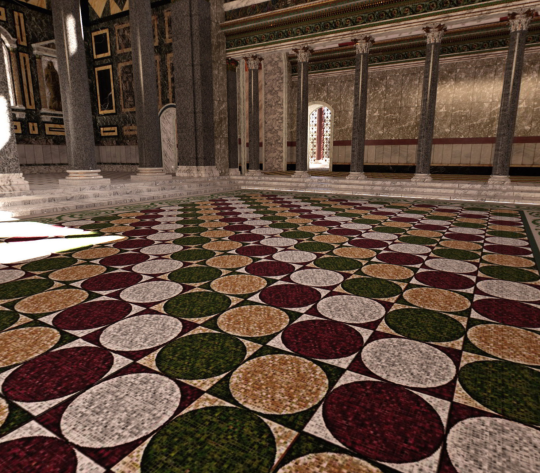
3D reconstruction of the palaestra in Baths of emperor Caracalla.
Made by Rome in 3D
These are some screenshots ( large images) that I took from the original 360 panorama image by 'Rome in 3D'
The work by Rome in 3D team received recognition from scientists in the field of 3D reconstruction, archaeology and topography of Rome.
695 notes
·
View notes
Text






Art
#digitalart #art #artportfolio #digitalartisiit #digitalpainting #girl #feminine #3D #3Datt
#art#digital art#artwork#original art#digital painting#digital illustration#3d art#ancient rome#classism#aesthetic#drawing#artists on tumblr#artist
0 notes
Text
We definitely would have been @creative-chaos-apparently! I actually made a few sarcophagi myself!
And you'd think I'd outgrow it buuut I've definitely 3D printed busts of Cleopatra, King Tut, Julius Caesar, Mark Antony, and Octavian. As well as a lithophane I quite like of Cleo I found on Thingiverse.
I did it in all white so it acts like a lithophane. Also added a hole in Tinkercad. Here it is on my window.

I did not create the original design, it was made by yb__magiic on Thingiverse. Here is the link:
So as a little kid I had a FURIOUS Egyptology phase. Not exactly the gods or anything— no I was obsessed with pyramids and mummification and all that jazz. Like I tried to steal that huge Egyptology book from the school library. It was bad.
In my art classes we had air dry crayola clay were asked to make something historical out of it. I made a shitload of little sarcophagi. Like a ton, including little ones for animals. I just found out TODAY about 13 years later that my mom has one of the cat ones on display in her curio cabinet 😭

This is just one of many weird, weird, things I did in elementary school. I was well recognized by teachers for being “very creative” but “struggling socially and in areas of non-creativity”
@historical-kitten we would’ve been great friends as little kids
#I'm a history geek#ancient egypt#ancient rome#3d printing#3d printer#lithophane#not my original post#also didn't have any of my kid art stuff ag hand so shared a current one xD
13 notes
·
View notes
Text


𝓢HIFTING ✶ central . . .


under construction because some of my posts need to be sorted out!!
i , 𝓼kipping to the important bit . . . ౨ৎ
◞ how 2 shift
◞ how i personally shift all the time.
◞ my own method
◞ my method and how to let go.
◞ more detail about my method.
◞ how to induce the void.
◞ the reasons why you're waking up in your cr
◞ how to stop looking at the 3d for results.
◞ where is the stuff i manifested?

⊹ ︶︶ ୨୧ ︶︶ ⊹
ii , 𝓽hings to script with beauty . . . ౨ৎ
◞ coppola
◞ ethereal
◞ monroe
◞ bunny
◞ veela
◞ siren.

iii , 𝓽hings to remember when you're doubting shifting . . . ౨ৎ
◞ never listen to an anti-shifter.
◞ doubts, doubts, doubts.
◞ how to get over the fear of never shifting.

iv , 𝓼tack of casettes from yours truly . . . ౨ৎ
◞ how to manifest the future.
◞ are we in a matrix?
◞ paradoxical intention
◞ manifestation vs shifting . . . how you're doing both. and then some more!
◞ adjustments periods
◞ you're not sisyphus
◞ you can manifest anything in hours, minutes, and even seconds
◞ no one can shift or manifest for you but you.
◞ stop putting pressure on shifting &&& loa.
◞ you've never left your dr.
◞ energy and matter cannot be destroyed or created.
◞ barbie doll theory of self-concept.
◞ how to stay connected to your dr.
v , 𝓶y guide to scripts and all else ! . . . ౨ৎ
◞ pick a card, find out about your loa & shifting journey.
◞ pick one, and let intuition guide you.
◞ your shifting journey based on your astrology.
◞ marauders dr template.
◞ how to survive in ancient rome.
◞ how to survive in ancient egypt.
◞ how to survive in ancient greece.
◞ how to survive in 19th century france.
◞ how to survive in ancient babylon ( incoming! ).
◞ how to survive in ancient china.

,
vi , 𝓶y personal experience . . . ౨ৎ
◞ adjustment period
◞ things i manifested in the last 6 months
◞ things i've learned from shifting

#ib solanasreality#reality shifting#reality shifting community#shifting advice#shifting consciousness#shifting reality#reality shift#reality shifter#shiftblr#loassblog#law of assumption#loassumption#loablr#manifesting#shifting#shifting community#shifting motivation#desired reality#loa tumblr#loa blog#loa success
288 notes
·
View notes
Text
Gladiator ii thoughts
i feel for Paul Mescal, alone in a green screen, fighting imaginary 3d monkeys
we get the fallacy of the good emperor vs the power abusers that ruin the imperial experience for everyone :(
the scrpt’s need of a white protag as a victim of imperialism (paul mescal is good, just pointing out a trope)
denzel is loads of fun
the gladiator riding a rhino carrying ancient rome boleadoras?!?!! 🥴 (not to mention the newspaper guy, but everyone saw that)
some scenes dealing with the transformation of submission and conquer into spectacle Rome (and others less ancient) had going on are actually good, (i liked hanno and macrinus’s exchanges, and the scene that ends with hanno reciting virgil) but sadly there’s a lot of effort to make the fights actually fun and engaging to the audience of the movie which, undermines that stance
scene borrowed from Spartacus (when Hanno attacks the emperors’s box from the arena! the walls of the spectacle blur and reach the untouchables!)(kubrick did it better. better editing, faster, less predictable)
Symbolic lavander sniffing (I actually like that, makes Lucilla look kiinda hypocritical)
i support Denzel Washington, giving it his all living his own shakespearean subplot (and for what)
(actual good scene between him and lucilla where he reveals he was Aurelius’s slave, apparently dismantling the myth of the good tyrant for a second)(but for what, it doesn’t last)
Hanno forgetting his anti imperialism and consequent hatred of his own lineage bc he learns the lesson you can be a Good Imperialist™️
all of hanno’s virtues being explained in hindsight bc of his noble lineage (oh ofc he was a natural leader, it was in his blood, he inherited all of that from marcus aurelius, lucilla and maximus)
finally, hanno’s final speech to the gladiators is very annoying, masses of pocs portrayed as followers of a charismatic member of the imperial power
#i knew full well what i was walking into#ú_ù#but it was worse than I expected#pedro pascal and the twin twinks are not eve worth mentioning sadly. it was nothing
10 notes
·
View notes
Text

Michelangelo’s Masterpieces Are Getting a High-Tech Makeover
An experimental exhibition in Denmark is intended to spark debate about the future use of 3D-printed replicas in museums.
When it comes to critically-acclaimed museum shows, a high premium is usually placed on the uniqueness and rarity of the objects on display. Back in the day, however, copies of an ancient masterpiece would often have to do. This was how the marvels of Greek art made their way to workshops across the Roman empire, in due course influencing the Renaissance masters and Western culture at large. Not only would ideas spread far via reproduction, but otherwise site-specific art could be appreciated in new contexts.
Carrying this spirit into the 21st century, the National Gallery of Denmark (SMK) will present the most comprehensive Michelangelo exhibition since 1875, featuring a groundbreaking blend of 19th-century plaster casts and state-of-the-art 3D-printed replicas. Opening March 29, the show will reassemble scattered masterpieces and showcase works that rarely, if ever, leave their original locations, offering visitors a unique opportunity to experience the Renaissance master’s art.
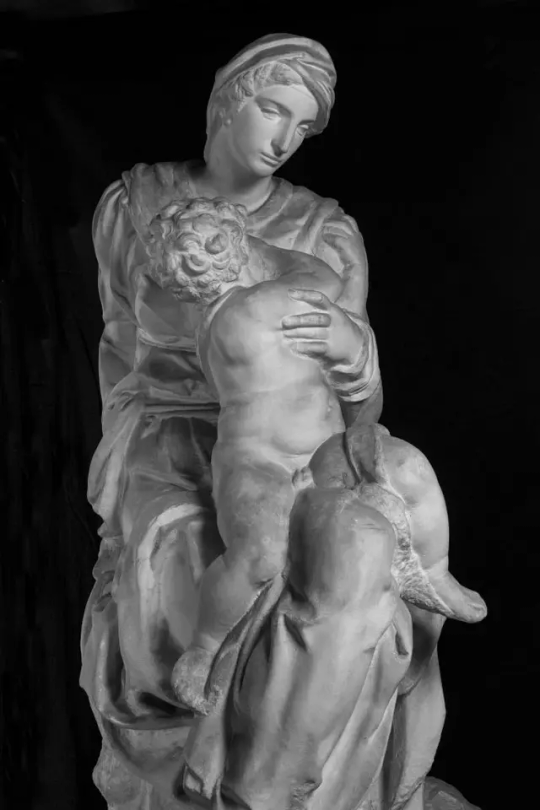
Plaster cast after Michelangelo Buonarroti, Medici Madonna. Original made ca. 1526–1532, cast in 1897. Photo: SMK – National Gallery of Denmark.
Using technology from Factum Arte in Madrid, the museum will enhance its collection of 19th-century plaster casts of Michelangelo masterpieces, such as the head of David and the Medici Madonna, with newly created 3D-printed replicas. These replicas provide access to works that are otherwise unattainable due to immobility or location. For instance, Michelangelo’s depictions of Saints Peter, Augustine, Paul, and Gregory are fixed elements of the Piccolomini Altarpiece in Siena, Italy installed so high that they cannot be easily viewed up close. Other works, like Cupid, are in high demand and geographically restricted, currently on loan to the Metropolitan Museum of Art in New York from France until 2029.
The show’s curator, Matthias Wivel, said he is not concerned that the use of replicas might be off-putting to audiences. “We will achieve a beautiful exhibition with them that will be compelling to the public,” he said. “The appreciation and study of art has always relied heavily on reproductions. Without them both would be much more limited. Used responsibly, there is huge potential and value in using reproductions.”
He conceded that the show is an experiment, and he will measure its success on its ability to “stimulate debate and prompt refinement or rejection, and innovation.”
Perhaps the strongest argument for the use of reproductions is greater freedom to build art historical narratives unbounded by practical limitations. For example, the show in Denmark will bring together several pieces originally produced for the tomb of Julius II that have since scattered across different locations. These include the Boboli Prisoners at the Accademia and Genius of Victory at the Palazzo Vecchio, both in Florence, and Rachel and Leah at San Pietro in Vincoli, Rome.
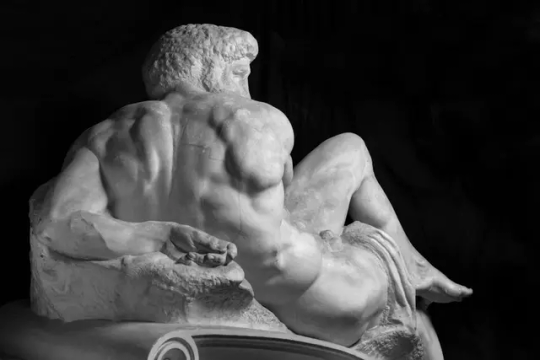
Plaster cast after Michelangelo Buonarroti, Day. Original ca. 1524-26, cast 1897. The Royal Cast Collection, SMK – National Gallery of Denmark Photo: SMK.
Factum Arte have also been able to reconstruct Infant John the Baptist from Ubedà, which was smashed during the Spanish Civil War. Though the statue has been restored, it still bears the scars of its destruction; the new 3D model was made by referencing archival photographs of the work from before the restoration. Wivel hopes it will “convey some of the wonder of the original.”
The exhibition will also reveal how much reproduction technologies have evolved over the centuries. According to Wivel, Factum Arte’s facsimiles made using digital techniques are accurate down to the micron level, resulting in pieces of “much higher fidelity than the plasters, in that they reproduce the color, surface, and detailing such as veining, of the marble.”
He also noted that digital facsimiles like those made by Factum Arte provide highly detailed records of artworks that may be valuable to researchers and restorers for centuries to come. Wivel noted that traveling as part of exhibition loans can cause significant physical strain on fragile objects as well. In other contexts, high-tech replicas have also played an important role in facilitating repatriation agreements, allowing museums to keep a copy of an object that they decide to return.
Together, these reproductions, both old and new, will enable the most comprehensive monographic exhibition dedicated to Michelangelo since 1875, when the 400th anniversary of his birth was celebrated in Florence. Running through August 31, the exhibition will also include a selection of Michelangelo’s original drawings, correspondence, models in wax and clay, and several bronzes made after models that are now lost.
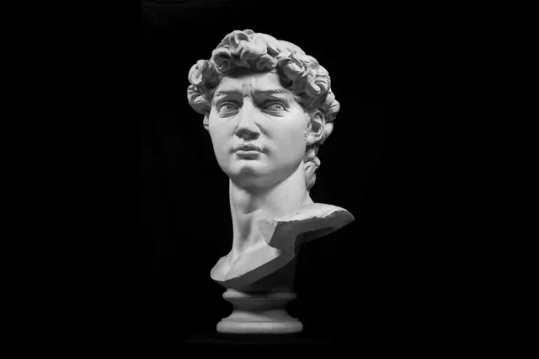
Plaster cast after Michelangelo Buonarroti, Head of David. Original made in 1501-1503, cast in 1890. Photo: SMK – National Gallery of Denmark.
By Jo Lawson-Tancred.
#Michelangelo#Michelangelo’s Masterpieces Are Getting a High-Tech Makeover#National Gallery of Denmark#Michelangelo Imperfect#italian artist#art#artist#art work#art world#art news#3D-printed replicas
18 notes
·
View notes
Text
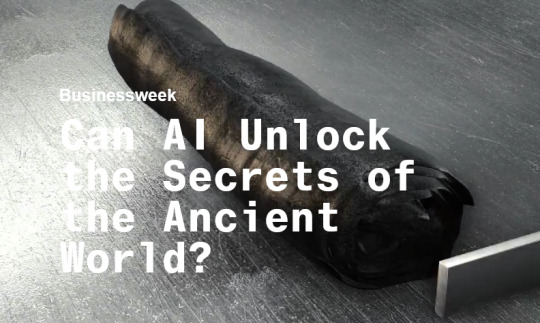
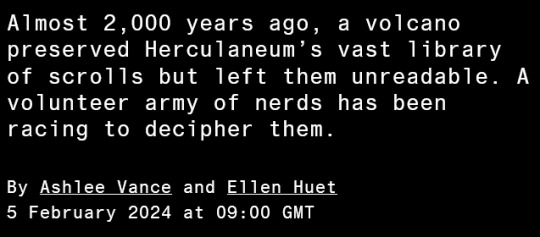
A few years ago, during one of California’s steadily worsening wildfire seasons, Nat Friedman’s family home burned down. A few months after that, Friedman was in Covid-19 lockdown in the Bay Area, both freaked out and bored. Like many a middle-aged dad, he turned for healing and guidance to ancient Rome. While some of us were watching Tiger King and playing with our kids’ Legos, he read books about the empire and helped his daughter make paper models of Roman villas. Instead of sourdough, he learned to bake Panis Quadratus, a Roman loaf pictured in some of the frescoes found in Pompeii. During sleepless pandemic nights, he spent hours trawling the internet for more Rome stuff. That’s how he arrived at the Herculaneum papyri, a fork in the road that led him toward further obsession. He recalls exclaiming: “How the hell has no one ever told me about this?”
The Herculaneum papyri are a collection of scrolls whose status among classicists approaches the mythical. The scrolls were buried inside an Italian countryside villa by the same volcanic eruption in 79 A.D. that froze Pompeii in time. To date, only about 800 have been recovered from the small portion of the villa that’s been excavated. But it’s thought that the villa, which historians believe belonged to Julius Caesar’s prosperous father-in-law, had a huge library that could contain thousands or even tens of thousands more. Such a haul would represent the largest collection of ancient texts ever discovered, and the conventional wisdom among scholars is that it would multiply our supply of ancient Greek and Roman poetry, plays and philosophy by manyfold. High on their wish lists are works by the likes of Aeschylus, Sappho and Sophocles, but some say it’s easy to imagine fresh revelations about the earliest years of Christianity.
“Some of these texts could completely rewrite the history of key periods of the ancient world,” says Robert Fowler, a classicist and the chair of the Herculaneum Society, a charity that tries to raise awareness of the scrolls and the villa site. “This is the society from which the modern Western world is descended.”
The reason we don’t know exactly what’s in the Herculaneum papyri is, y’know, volcano. The scrolls were preserved by the voluminous amount of superhot mud and debris that surrounded them, but the knock-on effects of Mount Vesuvius charred them beyond recognition. The ones that have been excavated look like leftover logs in a doused campfire. People have spent hundreds of years trying to unroll them—sometimes carefully, sometimes not. And the scrolls are brittle. Even the most meticulous attempts at unrolling have tended to end badly, with them crumbling into ashy pieces.
In recent years, efforts have been made to create high-resolution, 3D scans of the scrolls’ interiors, the idea being to unspool them virtually. This work, though, has often been more tantalizing than revelatory. Scholars have been able to glimpse only snippets of the scrolls’ innards and hints of ink on the papyrus. Some experts have sworn they could see letters in the scans, but consensus proved elusive, and scanning the entire cache is logistically difficult and prohibitively expensive for all but the deepest-pocketed patrons. Anything on the order of words or paragraphs has long remained a mystery.
But Friedman wasn’t your average Rome-loving dad. He was the chief executive officer of GitHub Inc., the massive software development platform that Microsoft Corp. acquired in 2018. Within GitHub, Friedman had been developing one of the first coding assistants powered by artificial intelligence, and he’d seen the rising power of AI firsthand. He had a hunch that AI algorithms might be able to find patterns in the scroll images that humans had missed.
After studying the problem for some time and ingratiating himself with the classics community, Friedman, who’s left GitHub to become an AI-focused investor, decided to start a contest. Last year he launched the Vesuvius Challenge, offering $1 million in prizes to people who could develop AI software capable of reading four passages from a single scroll. “Maybe there was obvious stuff no one had tried,” he recalls thinking. “My life has validated this notion again and again.”
As the months ticked by, it became clear that Friedman’s hunch was a good one. Contestants from around the world, many of them twentysomethings with computer science backgrounds, developed new techniques for taking the 3D scans and flattening them into more readable sheets. Some appeared to find letters, then words. They swapped messages about their work and progress on a Discord chat, as the often much older classicists sometimes looked on in hopeful awe and sometimes slagged off the amateur historians.
On Feb. 5, Friedman and his academic partner Brent Seales, a computer science professor and scroll expert, plan to reveal that a group of contestants has delivered transcriptions of many more than four passages from one of the scrolls. While it’s early to draw any sweeping conclusions from this bit of work, Friedman says he’s confident that the same techniques will deliver far more of the scrolls’ contents. “My goal,” he says, “is to unlock all of them.”
Before Mount Vesuvius erupted, the town of Herculaneum sat at the edge of the Gulf of Naples, the sort of getaway wealthy Romans used to relax and think. Unlike Pompeii, which took a direct hit from the Vesuvian lava flow, Herculaneum was buried gradually by waves of ash, pumice and gases. Although the process was anything but gentle, most inhabitants had time to escape, and much of the town was left intact under the hardening igneous rock. Farmers first rediscovered the town in the 18th century, when some well-diggers found marble statues in the ground. In 1750 one of them collided with the marble floor of the villa thought to belong to Caesar’s father-in-law, Senator Lucius Calpurnius Piso Caesoninus, known to historians today as Piso.
During this time, the first excavators who dug tunnels into the villa to map it were mostly after more obviously valuable artifacts, like the statues, paintings and recognizable household objects. Initially, people who ran across the scrolls, some of which were scattered across the colorful floor mosaics, thought they were just logs and threw them on a fire. Eventually, though, somebody noticed the logs were often found in what appeared to be libraries or reading rooms, and realized they were burnt papyrus. Anyone who tried to open one, however, found it crumbling in their hands.
Terrible things happened to the scrolls in the many decades that followed. The scientif-ish attempts to loosen the pages included pouring mercury on them (don’t do that) and wafting a combination of gases over them (ditto). Some of the scrolls have been sliced in half, scooped out and generally abused in ways that still make historians weep. The person who came the closest in this period was Antonio Piaggio, a priest. In the late 1700s he built a wooden rack that pulled silken threads attached to the edge of the scrolls and could be adjusted with a simple mechanism to unfurl the document ever so gently, at a rate of 1 inch per day. Improbably, it sort of worked; the contraption opened some scrolls, though it tended to damage them or outright tear them into pieces. In later centuries, teams organized by other European powers, including one assembled by Napoleon, pieced together torn bits of mostly illegible text here and there.
Today the villa remains mostly buried, unexcavated and off-limits even to the experts. Most of what’s been found there and proven legible has been attributed to Philodemus, an Epicurean philosopher and poet, leading historians to hope there’s a much bigger main library buried elsewhere on-site. A wealthy, educated man like Piso would have had the classics of the day along with more modern works of history, law and philosophy, the thinking goes. “I do believe there’s a much bigger library there,” says Richard Janko, a University of Michigan classical studies professor who’s spent painstaking hours assembling scroll fragments by hand, like a jigsaw puzzle. “I see no reason to think it should not still be there and preserved in the same way.” Even an ordinary citizen from that time could have collections of tens of thousands of scrolls, Janko says. Piso is known to have corresponded often with the Roman statesman Cicero, and the apostle Paul had passed through the region a couple of decades before Vesuvius erupted. There could be writings tied to his visit that comment on Jesus and Christianity. “We have about 800 scrolls from the villa today,” Janko says. “There could be thousands or tens of thousands more.”
In the modern era, the great pioneer of the scrolls is Brent Seales, a computer science professor at the University of Kentucky. For the past 20 years he’s used advanced medical imaging technology designed for CT scans and ultrasounds to analyze unreadable old texts. For most of that time he’s made the Herculaneum papyri his primary quest. “I had to,” he says. “No one else was working on it, and no one really thought it was even possible.”
Progress was slow. Seales built software that could theoretically take the scans of a coiled scroll and unroll it virtually, but it wasn’t prepared to handle a real Herculaneum scroll when he put it to the test in 2009. “The complexity of what we saw broke all of my software,” he says. “The layers inside the scroll were not uniform. They were all tangled and mashed together, and my software could not follow them reliably.”
By 2016 he and his students had managed to read the Ein Gedi scroll, a charred ancient Hebrew text, by programming their specialized software to detect changes in density between the burnt manuscript and the burnt ink layered onto it. The software made the letters light up against a darker background. Seales’ team had high hopes to apply this technique to the Herculaneum papyri, but those were written with a different, carbon-based ink that their imaging gear couldn’t illuminate in the same way.
Over the past few years, Seales has begun experimenting with AI. He and his team have scanned the scrolls with more powerful imaging machines, examined portions of the papyrus where ink was visible and trained algorithms on what those patterns looked like. The hope was that the AI would start picking up on details that the human eye missed and could apply what it learned to more obfuscated scroll chunks. This approach proved fruitful, though it remained a battle of inches. Seales’ technology uncovered bits and pieces of the scrolls, but they were mostly unreadable. He needed another breakthrough.
Friedman set up Google alerts for Seales and the papyri in 2020, while still early in his Rome obsession. After a year passed with no news, he started watching YouTube videos of Seales discussing the underlying challenges. Among other things, he needed money. By 2022, Friedman was convinced he could help. He invited Seales out to California for an event where Silicon Valley types get together and share big ideas. Seales gave a short presentation on the scrolls to the group, but no one bit. “I felt very, very guilty about this and embarrassed because he’d come out to California, and California had failed him,” Friedman says.
On a whim, Friedman proposed the idea of a contest to Seales. He said he’d put up some of his own money to fund it, and his investing partner Daniel Gross offered to match it.
Seales says he was mindful of the trade-offs. The Herculaneum papyri had turned into his life’s work, and he wanted to be the one to decode them. More than a few of his students had also poured time and energy into the project and planned to publish papers about their efforts. Now, suddenly, a couple of rich guys from Silicon Valley were barging into their territory and suggesting that internet randos could deliver the breakthroughs that had eluded the experts.
More than glory, though, Seales really just hoped the scrolls would be read, and he agreed to hear Friedman out and help design the AI contest. They kicked off the Vesuvius Challenge last year on the Ides of March. Friedman announced the contest on the platform we fondly remember as Twitter, and many of his tech friends agreed to pledge their money toward the effort while a cohort of budding papyrologists began to dig into the task at hand. After a couple of days, Friedman had amassed enough money to offer $1 million in prizes, along with some extra money to throw at some of the more time-intensive basics.
Friedman hired people online to gather the existing scroll imagery, catalog it and create software tools that made it easier to chop the scrolls into segments and to flatten the images out into something that was readable on a computer screen. After finding a handful of people who were particularly good at this, he made them full members of his scroll contest team, paying them $40 an hour. His hobby was turning into a lifestyle.
The initial splash of attention helped open new doors. Seales had lobbied Italian and British collectors for years to scan his first scrolls. Suddenly the Italians were now offering up two new scrolls for scanning to provide more AI training data. With Friedman’s backing, a team set to work building precision-fitting, 3D-printed cases to protect the new scrolls on their private jet flight from Italy to a particle accelerator in England. There they were scanned for three days straight at a cost of about $70,000.
Seeing the imaging process in action drives home both the magic and difficulty inherent in this quest. One of the scroll remnants placed in the scanner, for example, wasn’t much bigger than a fat finger. It was peppered by high-energy X-rays, much like a human going through a CT scan, except the resulting images were delivered in extremely high resolution. (For the real nerds: about 8 micrometers.) These images were virtually carved into a mass of tiny slices too numerous for a person to count. Along each slice, the scanner picked up infinitesimal changes in density and thickness. Software was then used to unroll and flatten out the slices, and the resulting images looked recognizably like sheets of papyrus, the writing on them hidden.
The files generated by this process are so large and difficult to deal with on a regular computer that Friedman couldn’t throw a whole scroll at most would-be contest winners. To be eligible for the $700,000 grand prize, contestants would have until the end of 2023 to read just four passages of at least 140 characters of contiguous text. Along the way, smaller prizes ranging from $1,000 to $100,000 would be awarded for various milestones, such as the first to read letters in a scroll or to build software tools capable of smoothing the image processing. With a nod to his open-source roots, Friedman insisted these prizes could be won only if the contestants agreed to show the world how they did it.
Luke Farritor was hooked from the start. Farritor—a bouncy 22-year-old Nebraskan undergraduate who often exclaims, “Oh, my goodness!”—heard Friedman describe the contest on a podcast in March. “I think there’s a 50% chance that someone will encounter this opportunity, get the data and get nerd-sniped by it, and we’ll solve it this year,” Friedman said on the show. Farritor thought, “That could be me.”
The early months were a slog of splotchy images. Then Casey Handmer, an Australian mathematician, physicist and polymath, scored a point for humankind by beating the computers to the first major breakthrough. Handmer took a few stabs at writing scroll-reading code, but he soon concluded he might have better luck if he just stared at the images for a really long time. Eventually he began to notice what he and the other contestants have come to call “crackle,” a faint pattern of cracks and lines on the page that resembles what you might see in the mud of a dried-out lakebed. To Handmer’s eyes, the crackle seemed to have the shape of Greek letters and the blobs and strokes that accompany handwritten ink. He says he believes it to be dried-out ink that’s lifted up from the surface of the page.
The crackle discovery led Handmer to try identifying clips of letters in one scroll image. In the spirit of the contest, he posted his findings to the Vesuvius Challenge’s Discord channel in June. At the time, Farritor was a summer intern at SpaceX. He was in the break room sipping a Diet Coke when he saw the post, and his initial disbelief didn’t last long. Over the next month he began hunting for crackle in the other image files: one letter here, another couple there. Most of the letters were invisible to the human eye, but 1% or 2% had the crackle. Armed with those few letters, he trained a model to recognize hidden ink, revealing a few more letters. Then Farritor added those letters to the model’s training data and ran it again and again and again. The model starts with something only a human can see—the crackle pattern—then learns to see ink we can’t.
Unlike today’s large-language AI models, which gobble up data, Farritor’s model was able to get by with crumbs. For each 64-pixel-by-64-pixel square of the image, it was merely asking, is there ink here or not? And it helped that the output was known: Greek letters, squared along the right angles of the cross-hatched papyrus fibers.
In early August, Farritor received an opportunity to put his software to the test. He’d returned to Nebraska to finish out the summer and found himself at a house party with friends when a new, crackle-rich image popped up in the contest’s Discord channel. As the people around him danced and drank, Farritor hopped on his phone, connected remotely to his dorm computer, threw the image into his machine-learning system, then put his phone away. “An hour later, I drive all my drunk friends home, and then I’m walking out of the parking garage, and I take my phone out not expecting to see anything,” he says. “But when I open it up, there’s three Greek letters on the screen.”
Around 2 a.m., Farritor texted his mom and then Friedman and the other contestants about what he’d found, fighting back tears of joy. “That was the moment where I was like, ‘Oh, my goodness, this is actually going to work. We’re going to read the scrolls.’”
Soon enough, Farritor found 10 letters and won $40,000 for one of the contest’s progress prizes. The classicists reviewed his work and said he’d found the Greek word for “purple.”
Farritor continued to train his machine-learning model on crackle data and to post his progress on Discord and Twitter. The discoveries he and Handmer made also set off a new wave of enthusiasm among contestants, and some began to employ similar techniques. In the latter part of 2023, Farritor formed an alliance with two other contestants, Youssef Nader and Julian Schilliger, in which they agreed to combine their technology and share any prize money.
In the end, the Vesuvius Challenge received 18 entries for its grand prize. Some submissions were ho-hum, but a handful showed that Friedman’s gamble had paid off. The scroll images that were once ambiguous blobs now had entire paragraphs of letters lighting up across them. The AI systems had brought the past to life. “It’s a situation that you practically never encounter as a classicist,” says Tobias Reinhardt, a professor of ancient philosophy and Latin literature at the University of Oxford. “You mostly look at texts that have been looked at by someone before. The idea that you are reading a text that was last unrolled on someone’s desk 1,900 years ago is unbelievable.”
A group of classicists reviewed all the entries and did, in fact, deem Farritor’s team the winners. They were able to stitch together more than a dozen columns of text with entire paragraphs all over their entry. Still translating, the scholars believe the text to be another work by Philodemus, one centered on the pleasures of music and food and their effects on the senses. “Peering at and beginning to transcribe the first reasonably legible scans of this brand-new ancient book was an extraordinarily emotional experience,” says Janko, one of the reviewers. While these passages aren’t particularly revelatory about ancient Rome, most classics scholars have their hopes for what might be next.
There’s a chance that the villa is tapped out—that there are no more libraries of thousands of scrolls waiting to be discovered—or that the rest have nothing mind-blowing to offer. Then again, there’s the chance they contain valuable lessons for the modern world.
That world, of course, includes Ercolano, the modern town of about 50,000 built on top of ancient Herculaneum. More than a few residents own property and buildings atop the villa site. “They would have to kick people out of Ercolano and destroy everything to uncover the ancient city,” says Federica Nicolardi, a papyrologist at the University of Naples Federico II.
Barring a mass relocation, Friedman is working to refine what he’s got. There’s plenty left to do; the first contest yielded about 5% of one scroll. A new set of contestants, he says, might be able to reach 85%. He also wants to fund the creation of more automated systems that can speed the processes of scanning and digital smoothing. He’s now one of the few living souls who’s roamed the villa tunnels, and he says he’s also contemplating buying scanners that can be placed right at the villa and used in parallel to scan tons of scrolls per day. “Even if there’s just one dialogue of Aristotle or a beautiful lost Homeric poem or a dispatch from a Roman general about this Jesus Christ guy who’s roaming around,” he says, “all you need is one of those for the whole thing to be more than worth it.”
26 notes
·
View notes